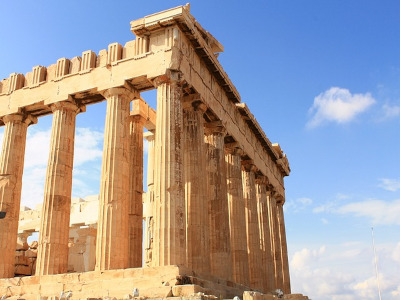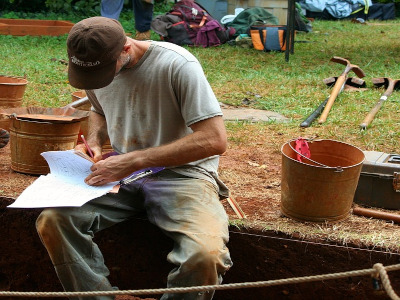Nowadays, every important memory can be captured through cameras, cell phones, and sound recordings. These kinds of materials can be used by future generations of people to understand how we live in the 21st century. Since we not only save the recordings locally on our devices but also on online clouds and storage systems, it will probably be easy to access this proof of our lives and human existence. With this evidence of our progressive technology, it is possible to capture important events of political movements or social existence that reflect traits that we carry in us as a community. But how were we able to capture evidence of our existence hundreds of thousands of years ago, and how do we know today so much about life in the past? A lot of this knowledge that we gained has been gathered through archaeological research and insights.
First off, the word origin of “archaeology” comes from the Greek words “archaia,” which means “ancient things,” and “logos” which can be translated to “theory” or “science”. Archaeology deals with the subject area of scientific research into the human past. Based on the findings, researchers are able to provide information about human activities and lifestyles. These findings can be all sorts of ancient artifacts, for example, pottery jars, glass fragments, tile fragments, remains of clothing, tools, and much more.

-gr%C3%A9cia-2118627/
Also, archaeologists do not only excavate the whole day old vases or bricks from ancient temples, but they also must do a lot of analysis in their everyday work. Furthermore, he has to describe the object he studies in order to determine to which epoch and geographical area the object belongs. Maybe there is even something written on them. Then the next step is to determine the language that provides more information about the origin of the artifact. All this research contributes to a better understanding and the acquisition of knowledge over the course of human life. With these investigations, it is possible to uncover information from ancient times, from the lives of cavemen to the era of ancient Egypt and everything in between.
The work of an archaeologist is often intertwined with the knowledge of other scientists, like geographers, historians, botanists, and even physicists and chemists. Even though the study methods that are used in archaeology are all scientific, archaeology is not an acknowledged natural science. Some people refer to it as a “discipline” that describes both human study fields and scientific ones.
Since the history of humanity is so diverse and multi-layered, it is impossible to cover all the fields at the same time. There are many substudy fields that only treat certain geographical zones. There are subbranches for ancient Greece, Egypt, and Rome, but also subdivisons by time periods like classical archaeology, medieval archaeology, and industrial archaeology.
Archaeological methods
Moreover, there are also different methods that were used to uncover life in ancient times. These techniques help us uncover cultural and historical artifacts and learn about their origins.
Archaeobotany
Archaeobotany describes one of these research methods. Humans settled down almost everywhere in the world. Therefore, there are a lot of food leftovers. It is possible that they were conserved for a long time, for instance, through charring or drying. Even though these vegetable or grain leftovers are so small, they can still provide information about what the people’s eating habits were, what social status they had, which settlement or tribe they belonged to, and much more.
Aerial archaeology
Aerial archaeology provides information about ground structures that are hard to recognize from a distance. This is why satellite pictures can often tell us more about the “bigger picture”. For instance, a grainfield with seemingly random incisions in it can show from the satellite picture that these incisions stand for the ground plans of a former house.
Dendrochronology
Dendrochronology comes from the Greek word “δέντρο” which means “tree”. This method relies on the information that researchers can find out based on the number of circles on the tree stump. If in one area there are more trees with the same number of circles, this can reveal a lot about the age and time the tree is from as well as its surroundings.
Archaeometallurgy
Archaeometallurgy is a method that can tell us a lot about the past lives of our ancestors. The way they worked with different metals, for instance, forged, annealed, or cast, is an information source about the time they were from. It also tells us about the trading relations that existed in former times.
Underwater archaeology
Underwater archaeology uses new technologies, like diving robots, to explore the underwater world. Diving excavations also reveal a lot of artifacts from the past and the lifestyle people had.
Experimental archaeology
Experimental archaeology basically tries to understand the past by recreating it. This method originates in the Scandinavic and Anglo-Saxon areas. The archaeologists try to rebuild the daily lives of our ancestors by using only the tools and resources that were available to them. So, all the circumstances are the same.
Big archaeological finds

Pompeii
The event that occurred in the ancient Roman city of Pompeii is probably one of the most tragic ones in history. The volcanic eruption of Mount Vesuvius cost about 2000 people their lives, and a lot of people got injured. The people who managed to escape the floods of lava lost their homes and everything they ever possessed. Pompeii itself was destroyed completely. Everything that got buried under the layers of ash got “conserved” since no air or moisture could penetrate. This means that all buildings and bodies remain in the state from before the eruption. After this awful event, a lot of archaeological studies took place there that showed us how life in the Roman Era used to be.
The tomb of Tutankhamun
The royal tomb of Pharao, Tutankhamun, was discovered in 1922 by Howard Carter and George Herbert in the Valley of the Kings in Egypt. More than 2,000 valuable treasures got buried along with him. This discovery raised archaeological interest all over the world and contributed to our knowledge of ancient Egypt.
Terracotta Army
The Terracotta Army is a collection of figures that portray Qin Shi Huang’s army. Qin Shi Huang was the first emperor of China. The collection consists of about 8,000 soldiers. This work of art shows how Eastern armies were equipped and gives us great insights into the Empire of China and how it used to be.
Sources:
https://www.britannica.com/science/archaeology/Fieldwork
https://www.planet-wissen.de/geschichte/archaeologie/methoden_der_archaeologie/index.html
https://www.geo.de/geolino/wissen/9748-rtkl-pompeji-protokoll-des-infernos
https://www.thecompleteuniversityguide.co.uk/student-advice/what-to-study/top-ten-archaeological-discoveries
